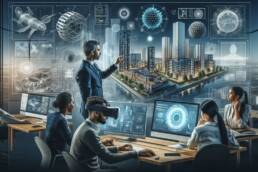3D architectural visualization is revolutionizing the way architects, developers, and marketers conceptualize and present their projects. By leveraging the power of 3D technology, professionals can create detailed, realistic models of buildings and spaces before they are built, providing a plethora of benefits that enhance the overall project development process. In this article, we’ll delve into the five key benefits of 3D architectural visualization that can make a significant impact on your next big project.
Key Takeaways
- 3D architectural visualization facilitates improved communication between architects, clients, and stakeholders by providing a clear visual representation of design concepts.
- It offers substantial cost savings by identifying potential design issues early in the process, reducing the need for expensive changes during construction.
- Error detection is streamlined with 3D models, allowing for corrections before construction begins, minimizing delays and additional costs.
- Marketing efficacy is greatly enhanced as photorealistic renderings and animations can be used as powerful marketing tools to attract investors and buyers.
- Dynamic presentations using 3D visualizations captivate audiences, provide immersive experiences, and make a lasting impression during pitches and sales meetings.
1. Enhanced Communication
We understand the importance of clear communication in bringing a project to life. The clarity provided by 3D visuals enhances communication, ensuring that all stakeholders are on the same page. This transparency is instrumental in setting realistic expectations and fostering trust between us and our clients.
Visualization is not just about stunning images; it’s a tool for better interaction. Here’s how it benefits our communication process:
- Clients can grasp the envisioned outcome with ease.
- It facilitates real-time collaboration among architects, engineers, and other stakeholders.
- Changes and ideas can be explored and implemented swiftly, avoiding misunderstandings.
By leveraging 3D architectural visualization, we ensure that additional information or instructions are conveyed effectively, catering to diverse needs and learning styles.
Our commitment to enhanced communication through visualization is echoed by our clients’ feedback. They appreciate the ability to see their projects come to life before construction begins, which not only excites them but also their neighbors and stakeholders involved.
2. Cost Reduction
We’ve witnessed firsthand the cost-effectiveness of 3D architectural visualization. As the technology becomes more accessible, the financial benefits are undeniable. By eliminating the need for full-scale mockups, we reduce not only material costs but also the time and labor involved in creating physical models.
Quality renders have the added advantage of cutting down on prototype expenses. This is particularly valuable for businesses looking to optimize their investment in the design phase. Here’s how 3D visualization contributes to cost savings:
- Early error detection prevents expensive changes during construction.
- Streamlined design approval process with fewer revisions.
- Enhanced collaboration and information exchange through BIM integration.
Embracing 3D visualization is not just about the aesthetic appeal; it’s a strategic move towards more efficient and cost-effective project management.
3. Error Detection
In our journey to perfecting the final design, 3D architectural visualization plays a pivotal role in early error detection. By visualizing the project in a virtual environment, we can identify and address potential issues before they manifest in the real world. This preemptive approach not only saves time but also significantly reduces the risk of costly post-construction corrections.
Real-time error detection is a game-changer in the architectural process. It allows us to make informed decisions about materials, structural integrity, and aesthetic appeal. Consider the following benefits:
- Early identification of design conflicts
- Visualization of material compatibility
- Assessment of structural feasibility
- Prevention of on-site construction errors
By integrating 3D visualization into our workflow, we ensure that every aspect of the design is scrutinized, leaving no room for oversight. This meticulous attention to detail is what sets us apart and guarantees the success of our projects.
4. Marketing Efficacy
In our journey to revolutionize project presentations, we’ve discovered that 3D architectural visualization is a game-changer in marketing. It’s not just about creating stunning visuals; it’s about crafting interactive experiences that captivate potential clients and stakeholders. With 3D models, we can showcase our projects in a way that traditional media could never achieve.
By integrating 3D visualization into our marketing strategies, we’re not just showing a concept; we’re bringing it to life. This immersive approach allows for a deeper connection with the audience, making it easier for them to envision themselves within the space.
Here’s how 3D visualization elevates our marketing campaigns:
- It enables interactive marketing campaigns that drive engagement.
- Provides an immersive product experience that resonates with viewers.
- Facilitates the creation of photorealistic images that capture attention.
- Allows for the testing of new concepts through social media engagement and feedback.
Moreover, the versatility of 3D visualization tools means we can adapt quickly to market demands and client feedback, ensuring our marketing materials are always fresh and relevant. As we look to the future, technologies like VR and AR are set to further transform the landscape of architectural visualization, making it an indispensable tool in our marketing arsenal.
5. Dynamic Presentations
We understand the transformative power of 3D architectural visualization, not just in the design phase but also when it comes to presenting our projects. Dynamic presentations elevate the experience from static images to interactive explorations of the space. With the ability to add dimensions, our clients can immerse themselves in the project, experiencing it as if they were physically present.
Interactive features such as real-time customization of finishes and lighting conditions empower stakeholders to make informed decisions. Data layers enhance this experience by allowing us to toggle different aspects of the project, like furniture or electrical installations, aiding in clear and effective client communication.
The benefits of 3D visualization extend from initial concepts to client presentations, providing clarity and precision in the architectural workflow.
Here’s how dynamic presentations can change the game:
- Creating realistic environments that showcase the project’s potential.
- Offering an immersive product experience that goes beyond traditional marketing.
- Allowing for a pitch to virtual panels, providing instant feedback and building confidence.
By harnessing these capabilities, we not only convey our vision but also facilitate a deeper connection between the project and its audience.
Elevate your presentations to the next level with our cutting-edge Dynamic Presentations service. At CG Viz Studio, we specialize in high-end 3D visualization that will captivate your audience and leave a lasting impression. Don’t let your ideas go unnoticed; visit our website to explore our portfolio and see how we can transform your vision into reality. Your next presentation could be the game-changer you’ve been looking for—reach out to us today!
Conclusion
In conclusion, 3D architectural visualization stands as a transformative force in the realm of design and construction. It not only enables a vivid portrayal of architectural concepts but also serves as a powerful communication tool, bridging the gap between technical plans and a client’s vision. The benefits of utilizing 3D visualization are manifold, including cost-effectiveness, early error detection, enhanced marketing potential, and the creation of more compelling presentations. As we’ve explored throughout this article, these advantages are not just theoretical but are echoed in the testimonials of satisfied clients and the successful projects of CG Viz Studio. Embracing 3D visualization is not just about keeping up with the industry trends; it’s about unlocking a new dimension of creativity and precision that can elevate your next big project to unprecedented heights.
Frequently Asked Questions
What is 3D architectural visualization and how does it benefit my project?
3D architectural visualization is the process of creating digital models of buildings or spaces before they are built, providing a realistic preview of the project. It enhances communication, reduces costs, helps in error detection, improves marketing strategies, and enables dynamic presentations.
Can 3D visualization help in detecting design errors before construction?
Yes, 3D visualization allows for early detection of design errors, enabling architects and developers to make necessary changes before construction begins, saving time and money.
How does CG Viz Studio ensure the quality of their 3D visualizations?
CG Viz Studio employs a team of skilled artists and uses advanced software to create highly realistic images and animations, ensuring the quality of their 3D visualizations meets client expectations.
Is 3D visualization cost-effective compared to traditional methods?
3D visualization is cost-effective as it reduces the need for physical models and iterations, and helps in making informed decisions that can prevent costly changes during construction.
Can I use 3D architectural visualizations for marketing purposes?
Yes, 3D architectural visualizations serve as powerful marketing tools, providing potential buyers or investors with a clear and engaging representation of the project.
What kind of projects can benefit from 3D architectural visualization?
All types of architectural projects, including residential, commercial, and industrial buildings, as well as interior design and urban planning, can benefit from 3D architectural visualization.



